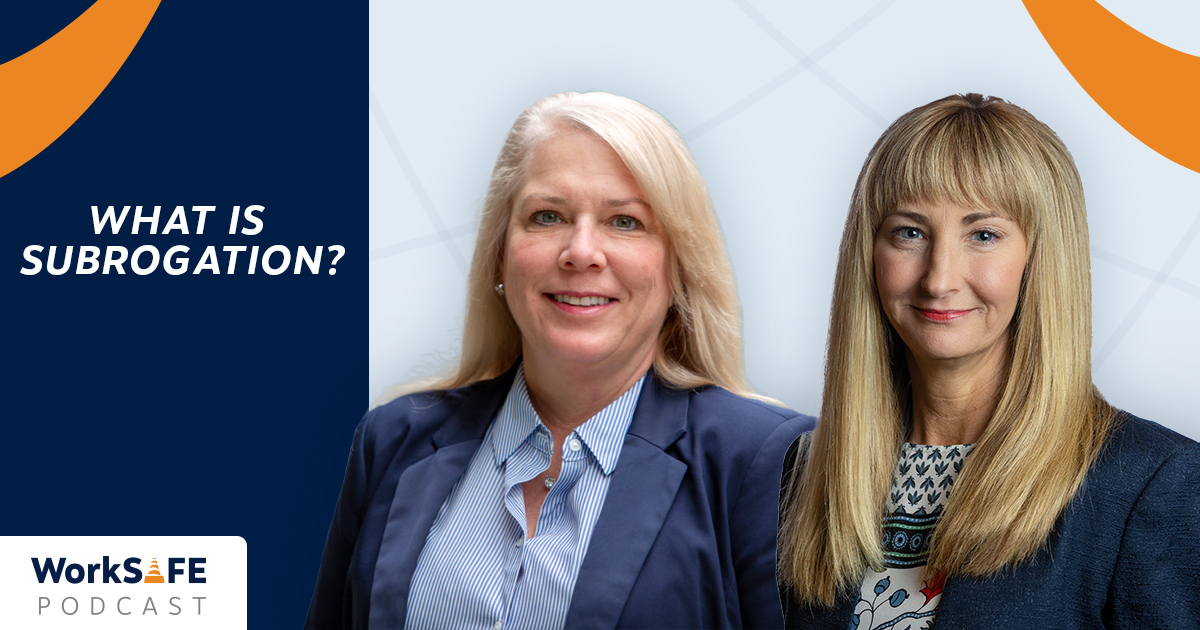Have you ever been involved in an incident that appeared only to be partially or entirely not your fault? Perhaps you were involved in a fender bender or have been injured while out and about. These situations can get complicated quickly. It can often become a he-said, she-said disagreement. Workers compensation insurance companies have tools and resources to help sort through the facts. When another party is liable for damage or injuries, a vital process begins called subrogation.
On this episode of the WorkSAFE Podcast, we sit down with Michelle Palmer. She is the Subrogation Manager at Missouri Employers Mutual. Palmer has over 27 years of experience in the insurance industry, working for carriers and third-party administrators. Her professional expertise extends to multistate work comp claims, subrogation, and liability claims.
First, we’ll explain what the subrogation process is. Then, we’ll share why it benefits employers during claims. Finally, we’ll detail a few questions employers can answer to make future subrogation easier.
Listen to this interview on the WorkSAFE Podcast, or read the show notes below.
What is subrogation?
Subrogation is a term that describes the right insurance companies have to pursue a third party who caused an incident legally. “The term third party refers to someone other than the insured or their employee,” Palmer explained. For example, a third party may be a reckless driver on the road or the manufacturer of faulty factory equipment. The subrogation process allows a work comp carrier to recover money spent on a claim.
How the process begins
At MEM, a case with the subrogation potential is referred to the Subrogation Unit. Then, a representative is assigned to complete an investigation. “They typically will contact the insured to collect any information and ask questions that clearly there’s not enough room for on their first report of injury or when someone’s reporting a claim,” Palmer shared.
If the representative needs a more hands-on approach, then a Field Service Manager will be assigned to the claim. “They are the eyes and ears in the field, and they are so valuable,” she added. “They collect a lot of very important information. Sometimes, when an incident involves a piece of equipment or machinery, the subrogation rep may decide that an expert needs to be involved.” An expert can provide more specific background and information.
Disputed liability: When both parties are at fault
When both parties are at fault in an incident, the situation is called disputed liability. Disputed liability is often seen in motor vehicle accidents or faulty product incidents. Having a Field Service Manager at the scene is essential in these cases. They can collect evidence, walk the incident scene, and better understand what happened at a specific time and place. The sooner these inquiries happen, the better.
“Getting experts or Field Service Managers involved early on is so vitally important because it gives us a lot of times the upper hand,” Palmer explained. Not all companies pursue subrogation. Further, the ones that only sometimes utilize team members to do a physical investigation. “Then we have bolstered or enhanced or maximized evidence and the information to potentially receive the best outcome.”
Serious claims involve legal counsel
During more severe and complex claims, legal counsel steps in. “We do utilize designated subrogation attorneys and counsel to make sure that, beyond the investigation, make sure that the appropriate parties are being placed on notice.” Sometimes, this means partnering with the third party’s counsel. For instance, they might inspect an incident scene or a defective machine together. This ensures everyone can access the same evidence, facts, and information used in a claim.
Benefits of the subrogation process
Some employers may not think of subrogation as a benefit. After all, a carrier is collecting back funds owed to them. However, an incident affects an employer’s experience modification factor (e-mod). A high e-mod can cause premium rates to rise. Getting funds back from a third party can change things. “If a recovery is made, then that will ultimately reduce the cost of that claim,” Palmer explained.
The possibility of subrogation isn’t limited to motor vehicle accidents and faulty equipment claims. Palmer has worked through the subrogation process on claims ranging from slips and falls to assault. “We approach each claim on its own merits because each claim has investigation parameters that need to be followed in order to capture the information,” Palmer shared.
The reality of legal action
Subrogation can help work comp carriers recover funds fairly. It can also help protect a business’ e-mod. But this doesn’t always mean the process is quick or the results are immediately known. Weeks, months, or even years can be needed to resolve the claim. This is especially true if a third party’s legal team disagrees with the evidence presented, isn’t willing to negotiate, or rejects a proposed compromise.
The status of an injured worker involved can also slow a claim. Time is often needed to know how severe an injury is or if a worker has recovered to the fullest degree possible.
Subrogation: Setting your business up for success
“The best defense is a good offense,” Palmer shared. “Well, in relation to insurance claims, taking a proactive approach is the best game plan.” For business owners, this means preparing in advance. Palmer recommends having incident ‘drills.’ In the same way a fire drill prepares employees for the unexpected, an incident drill can do the same. These practice runs ensure employees know their role in an emergency. Preparation also means asking essential questions in advance, such as:
- Who will assist the injured worker? It can be easy to panic when an employee is injured on the job. Assign someone to focus on the injured worker. For example, they may stay with the injured worker until help arrives or drive them to the nearest urgent care clinic.
- Who will make the initial report? It’s vital to report an incident promptly. Assign someone to report the incident to your work comp carrier and any relevant labor organizations.
- Who will investigate the claim? The key to a successful investigation is securing an incident scene. Assign someone to take witness statements, photographs and video and tape off the incident area.
For free safety posters, sample policies, and safety toolkits, including our Injury Management Kit, visit our Resource Library. Then, learn about completing a successful incident investigation in this WorkSAFE episode.

